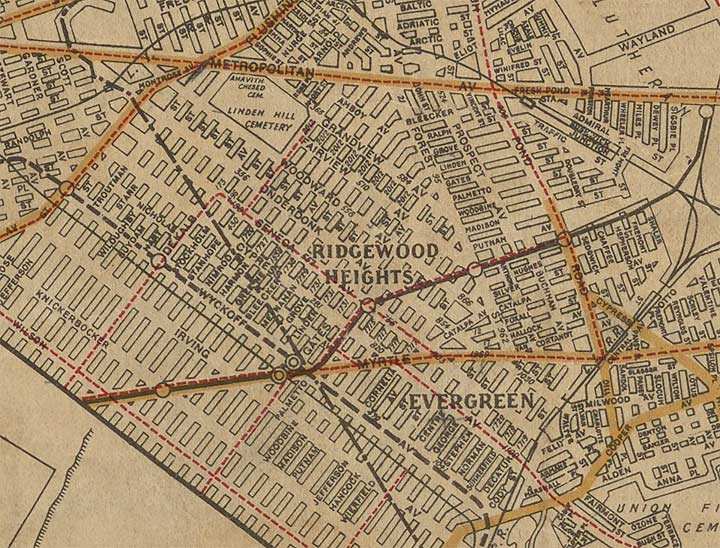
Today I once again wind the clock back into the past with a look at my newly acquired Hagstrom Queens map from 1922. The border of Brooklyn and Queens is unique among the five boroughs — much of it is land-based instead of the bodies of water separating the other boroughs from each other (except for a very short stretch of Manhattan-Bronx in Marble Hill). The Brooklyn-Queens border is not only undefended — no gates, passwords or Checkpoint Charlies — but it’s also unobtrusive. One would never know if (s)he is passing through the Brooklyn-Queens border without a sense of history and keenly honed observing skills.
There used to be an obvious tipoff: street sign color and style. Between 1964 and 1984, each borough had a different color street sign, as explained on this FNY page. Brooklyn signs were black with white letters and Queens white with blue letters. The federal government stepped in and ended this convenient tomfoolery in the early 1980s, mandating that (with some exceptions) highway and street signs must be green, to aid legibility.
Another method to tell Brooklyn apart from Queens is the house numbering system, which in Brooklyn, as with the rest of the USA, house numbers are unhyphenated. In the 1920s, when Queens streets were assigned numbers by its Topographic Bureau, a unique house numbering system was instituted with the first two digits demarking the avenue or street. Thus, my old address, 43-06 159th Street, was just south of 43rd Avenue.
However, Ridgewood, today’s subject, is a different bird. If we can assign it a personality, it has always fancied itself to be in Brooklyn, not Queens. The handsome attached rowhouses and brick stooped buildings have a distinct Brooklynian character, not the vague suburban quality large swaths of Queens has.
If we look at the 1922 map, this ambiguity is illustrated by the diagonal line that was the borough line, cutting across streets and in some cases, buildings. For many years, Ridgewood and its Brooklyn neighbor, Bushwick, shared a zip code. In 1925, the situation was remedied somewhat as the borough line was refitted along streets: Flushing Avenue, Cypress Avenue, Menahan Street, St. Nicholas Avenue, Gates Avenue, Wyckoff Avenue, Eldert Street, Irving Avenue and then cutting through Evergreens Cemetery to Highland Park and Cypress Hills.
Ridgewood-as-Brooklyn is also manifest in its streets not getting numbers by the Topographic Bureau. West of Forest Avenue, no Ridgewood street is numbered, and the hyphenated Queens style of house numbering doesn’t appear till you get east of Forest. After the 1920s, renumbering was sparse in any case, with Arthur Avenue becoming 60th Street, Prospect Avenue becoming 60th Place, and Buchanan Avenue becoming 60th Lane. Why, you’d think that every street was numbered 60 around here! (In nearby Maspeth they all seem to be numbered 59!) East of Fresh Pond Road, numbers begin taking over, as they mostly do in the rest of Queens.
Otherwise in 1922, there are separate sections called “Ridgewood Heights” and “Evergreen.” Both are early named since subsumed by just plain Ridgewood; Evergreen was so named for its proximity to Evergreens Cemetery, while a defunct Long Island Rail Road branch running through the area was also known by that name.
Note the thick black dotted line mostly on Wyckoff Avenue. That is the BMT Canarsie Line subway, today’s L train, in the planning stages in 1922 and built in stages from 6th Avenue to East New York from 1924 to 1928. Dotted red lines are streetcar lines, and abandoned trolley tracks can still be seen in the area poking above the asphalt.
“Comment as you see fit” kevinjudewalsh@gmail.com. (I am hoping to install a Disqus comment system on all new FNY pages soon, if I can parse out the HTML.)
1/21/17

1 comment
I grew up on St. Nicholas Avenue just off the corner of Greene, My father ( who grew up in the same house told me that there was once a line painted in the street on Greene Avenue between St. Nicholas and Cypress indicating where the Brooklyn Queens border was.